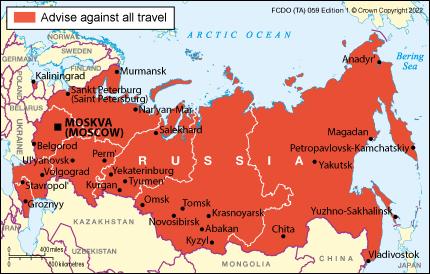In the midst of escalating tensions between Moscow and Washington, Russia is turning its diplomatic focus toward India, initiating a calculated charm offensive aimed at strengthening ties with the South Asian powerhouse. As relations between Russia and the United States continue to deteriorate, this strategic pivot marks a significant shift in Moscow’s foreign policy, underscoring India’s growing importance on the global geopolitical stage. This article explores the motivations behind Russia’s outreach, the key developments in Indo-Russian relations, and the potential implications for international diplomacy.
Russia Intensifies Diplomatic Outreach to India Amid Growing US Tensions
In an effort to counterbalance escalating tensions with the United States, Moscow has ramped up its diplomatic engagement with New Delhi. Recent high-level visits, cultural exchanges, and trade discussions underscore Russia’s strategic pivot towards strengthening ties with India. This intensified outreach aims not only at deepening political cooperation but also expanding economic partnerships in sectors such as energy, defense, and technology. Observers note that Russia is leveraging its long-standing historical connections with India to solidify a robust alliance amid global uncertainty.
Key areas of collaboration highlighted in recent talks include:
- Energy Security: Joint projects in nuclear power and natural gas supply.
- Defense Cooperation: Agreements on co-production and modernization of military equipment.
- Technology Sharing: Initiatives to foster innovation in aerospace and cybersecurity.
| Sector | Recent Developments | Impact |
|---|---|---|
| Energy | Expanded LNG exports to India | Increased energy supply stability |
| Defense | New joint military exercises planned | Enhanced strategic readiness |
| Technology | Launch of bilateral innovation hubs | Boost to tech advancements and job creation |
Strategic Benefits and Challenges of Russia India Rapprochement Explored
Russia’s renewed focus on India signals a calculated pivot amid escalating tensions with the United States. At the heart of this rapprochement lies a strategic balancing act: India gains a dependable partner in defense and energy while Russia diversifies its geopolitical alliances. This evolving partnership enhances India’s position as a counterweight to Western influence in Asia, offering access to affordable military technology and crucial energy supplies. For Russia, India represents a gateway to the Indo-Pacific, opening new economic corridors and reinforcing its relevance on the global stage despite Western sanctions.
However, this deepening cooperation is not without its complexities. Both nations must navigate sensitive issues such as aligning defense priorities with India’s growing ties to the West and managing the diplomatic tightrope involving China’s regional ambitions. Moreover, economic collaboration is constrained by currency exchange challenges and lingering mistrust rooted in decades of Cold War-era reservations.
- Benefits for India: Enhanced defense capabilities, diversified energy sources, strategic autonomy
- Benefits for Russia: Expanded Indo-Pacific presence, economic diversification, countering Western isolation
- Challenges: Conflicting alliances, economic friction, geopolitical uncertainties in Asia
| Aspect | Potential Impact |
|---|---|
| Defense Cooperation | Modernization & affordable tech |
| Energy Security | Stable supply, diversification |
| Diplomatic Leverage | Balanced global influence |
| Economic Ties | Growth opportunities hindered by sanctions |
Policy Recommendations for India to Navigate Between Moscow and Washington
To effectively balance its ties between Moscow and Washington amid growing geopolitical tensions, India must adopt a multi-layered diplomatic strategy that emphasizes strategic autonomy while safeguarding its national interests. First, New Delhi should enhance its diplomatic agility by conducting regular high-level dialogues separately with both capitals to clearly communicate its priorities and red lines. This approach allows India to extract maximum diplomatic and economic benefits without alienating either side. Furthermore, India can leverage its unique position as a crucial partner in areas like defense manufacturing, energy security, and technology cooperation to encourage mutual concessions from Russia and the US, ensuring that bilateral tensions do not undermine India’s long-term development goals.
In tandem with diplomacy, India must diversify its international partnerships beyond its traditional allies. Expanding strategic ties with other global powers and regional blocs will provide New Delhi more leverage to negotiate and buffer external pressures. The government should also revisit its foreign policy toolkit to include more robust economic incentives, trade diversification, and defense procurement transparency to maintain equilibrium. The table below outlines key focus areas to operationalize India’s balanced engagement:
| Focus Area | Diplomatic Action | Expected Outcome |
|---|---|---|
| Defense Cooperation | Joint exercises & tech sharing with both nations | Enhanced capabilities without exclusivity |
| Energy Security | Diversify energy imports from Russia and US allies | Reduced supply risks |
| Trade & Investment | Boost partnerships in non-sensitive sectors | Economic resilience & leverage |
| Strategic Communication | Consistent messaging emphasizing neutrality | Maintain trust & avoid misperceptions |
To Conclude
As geopolitical dynamics continue to evolve, Russia’s intensified diplomatic efforts in India signal a strategic pivot amid cooling ties with the United States. How this burgeoning partnership will influence the broader regional balance remains to be seen, but it undeniably marks a significant chapter in contemporary international relations. Observers will be closely watching India’s response as it navigates its relationships with two major powers in an increasingly complex global landscape.




